Emotions Entrusted to Us |
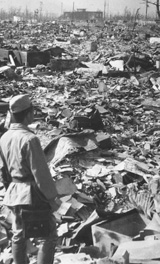
|
These are the new materials received in FY 2005. The materials donated in FY 2004 were displayed in the exhibition room, B1F, Hiroshima Peace Memorial Museum from July 2005 to July 2006. |
36 |
|
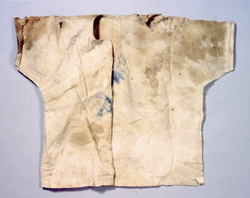 |
| 37 |
|
 |
Blouse
Junko Matsuda (then, 13)
Approx. 1,700m from the hypocenter
Donated by Sumie Kazumura (younger sister)
Junko Matsuda, a first-year student at Hiroshima Girls Commercial School, was exposed at her building demolition worksite near Tsurumi Bridge. She managed to escape to Nigitsu Shrine, where she collapsed. When Junko's family learned where she was, her older brother Hiroo pulled a large cart to the shrine. When he got Junko home, her family nursed her desperately. Nonetheless, on the 24th, as if following her father who died on the 9th, she died saying, "Father, wait for me!" Junko was wearing this blouse when she was exposed. |
|
Treasured figurine
Masako Hirata (then, 14)
Approx. 1,700m from the hypocenter
Donated by Terumasa Hirata (older brother)
Masako Hirata, a second-year student at Hiroshima Girls Commercial School, was exposed lined up with her class near the west end of Tsurumi Bridge. She staggered home to Ushita wearing only the elastic waistband of her monpe trousers and her canvas slip-on shoes. Masako was so terribly burned that her own mother could not recognize her until Masako responded to her. Masako died on the 14th. She had kept this favorite ornament on her desk.
|
 |
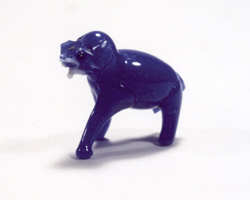 |
| 38 |
|
|
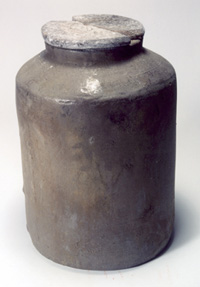 |
| 39 |
|
 |
Pot
Shizuo Tsuda (then, 57)
Approx. 1,700m from the hypocenter
Donated by Masami Tsuda (son's wife)
Shizuo Tsuda was exposed at home with his wife Setsuyo, and son Tatsuo. Shizuo was up on the roof removing roof tiles from his home slated for demolition. The family escaped to a relative's home nearby, but Shizuo died before the end of that year. The pot had been filled with pickled plums and buried under the house. Later, it was dug from the burnt ruins and served as an important source of nutrition during the scarcity after the war.
|
|
Kannon statue relief
Shuzo Ishibashi
Approx. 900m from the hypocenter
Donated by Shuichi Ishibashi (grandson)
Shuzo Ishibashi, director of Hiroshima Prefectural Hospital, was exposed in his office and trapped under the building when it collapsed. Somehow, working toward a beam of light that penetrated the pitch black, he worked his way out. As Hiroshima Prefectural Hospital had stored supplies and medicine at Furuta Elementary School in the western part of the city in case of emergency, it began relief activities there. Part of this statue he proudly displayed in his office was melted by the heat. |
 |
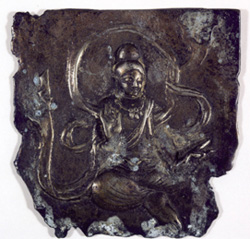 |
| 40 |
|
|
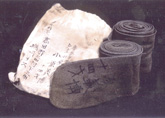 41
41 |
 |
Gaiters
Yoshihiro Obara (then, 12)
Approx. 600m from the hypocenter
Donated by Tamae Sakai (younger sister)
|
 |
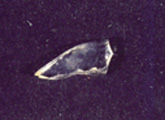 42
42 |
 |
Glass fragment extracted from her body
Shizue Tanishige (then, 30)
Approx. 1,020m from the hypocenter
Donated by Masuyuki Kobayashi (child)
|
| Yoshihiro Obara was a first-year student at Second Hiroshima Prefectural Junior High School. A mobilized student, Yoshihiro was exposed lined up for assembly at his building demolition site at Nakajima-shin-machi. Starting that evening, his father Iwao searched for him daily at various work sites. He was never able to find Yoshihiro. |
|
Shizue Tanishige was exposed at work. She was thrown by the blast and instantly put on her air-raid hood, but many glass fragments pierced her body. She made it to the home of her relatives in Yoshida-cho. Five or six years later, this piece of glass was surgically removed from Shizue's chest. |
|
 43
43 |
 |
Student uniform
Hiroaki Une (then, 12)
Place of exposure: unknown
Donated by Yoshie Chikashige (older sister)
|
 |
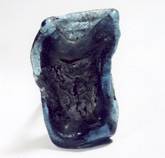 44
44 |
 |
Warped glass bottle
Bunji Akita (then, 15)
Donated by Sumiko Akita (wife)
|
| Hiroaki Une, a first-year student at First Hiroshima Prefectural Junior High School, was exposed on the way from his home to school. His mother, Hana, and older sister Yoshie looked desperately for him from the 7th (the next day) to the 15th (the end of the war). They never found Hiroaki. The last time the family saw him on the morning of the 6th. He had spied the train coming from far away and was rushing off while tying his gaiters on. Hana treasured his extra student uniform all these years. |
|
The day after the bombing, Bunji Akita was mobilized to join a rescue team in the city. During his week of relief activities at Honkawa Elementary School, he picked up this warped glass bottle. |
|
 45
45 |
 |
Personal seal
Sato Yamaka (then, 50)
Approx. 300m from the hypocenter
Donated by Eiso Yamaka (child)
|
 |
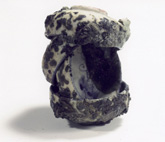 46
46 |
 |
Ceramic bowls fused in a stack
Yoshio Komoto (then, 18)
Approx. 900m from the hypocenter
Donated by Tadahisa Sasaki (younger brother)
|
| Sato Yamaka was killed by the bombing at home, Zaimoku-cho. When Eiso in Tokyo learned of the bombing, he returned to Hiroshima. On August 13, he was reunited with his older brother Yoshio. The next day, Eiso visited the burnt ruins of their home. In the family safe, the only possession to survive the fires, he found the personal seal that belonged to his mother, a Japanese dressmaker teacher. Eiso took it with him and treasured it as a keepsake. |
|
Yoshio Komoto was exposed at work, Ote-machi. Trapped under the collapsed company building, he desperately worked his way out only to encounter a sea of fire and driving black rain. He jumped into the Motoyasugawa River in front of the company and swam towards his home. Yoshio suffered such high fever, diarrhea, and vomiting blood that he expected to die. Somehow, he recovered. He found this in Sakai-machi about a month after the bombing. |
|
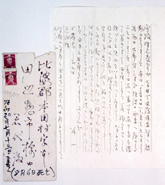 47
47 |
 |
Letter to a wife
Tameichi Zenitani (then, 37)
Donated by Kimiyo Zenitani (wife)
|
 |
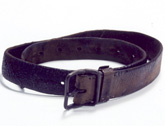 48
48 |
 |
Leather belt
Donated by Tsuyoshi Tamaoka
|
| Tameichi Zenitani was exposed near his dormitory at Ote-machi 5-chome. Learning of her husband's death, Kimiyo withstood family opposition and entered the city one week later carrying her newborn daughter and leading her older daughter and her son. They were unable to find Tameichi. Kimiyo treasured this letter that Tameichi had written to her on July 13, 1945. |
|
About 30 years after the war ended, Tsuyoshi Tamaoka found this leather belt. A soldier during the war, he immediately recognized it as an army belt. Because a part is burned, he thought it had been exposed to the atomic bombing and felt he had to keep it. Probably, the owner of the belt was wearing the belt when he was exposed from the back. |
|

